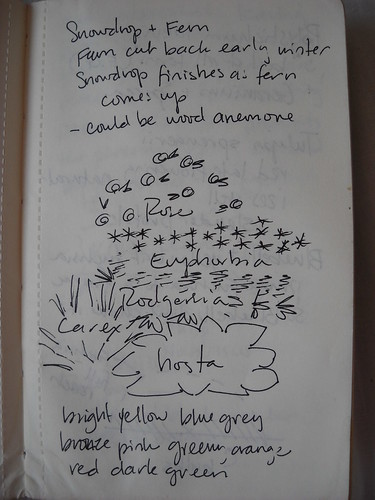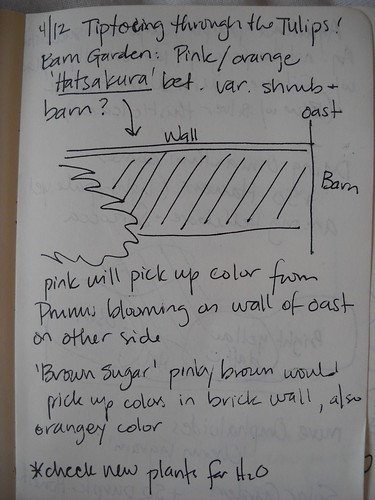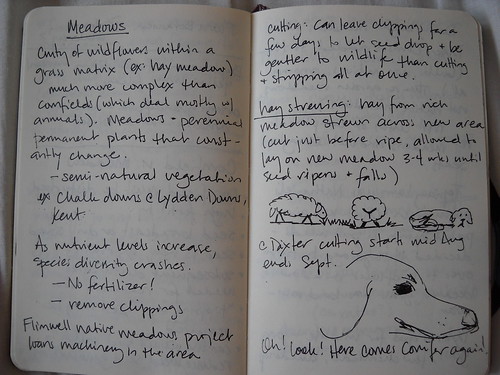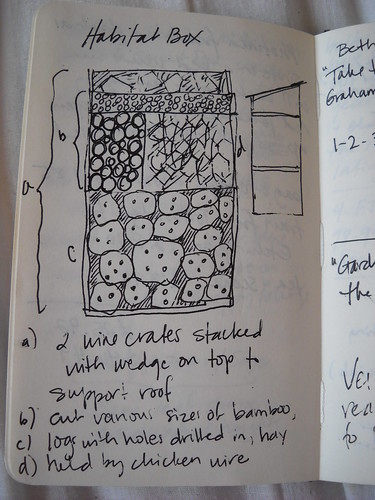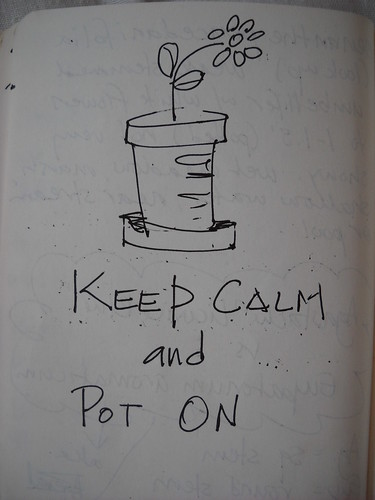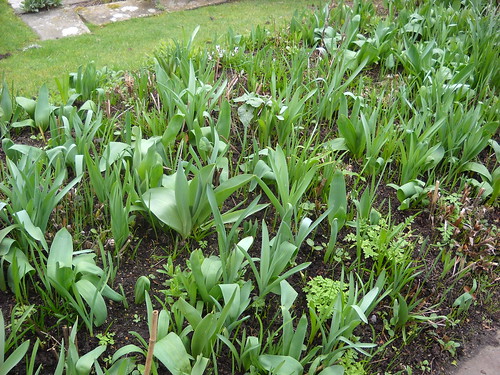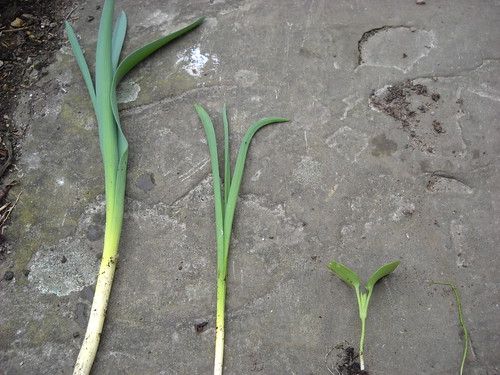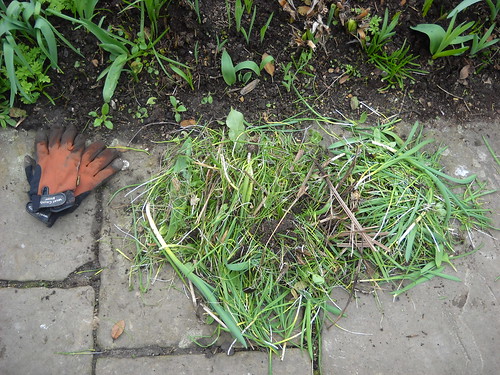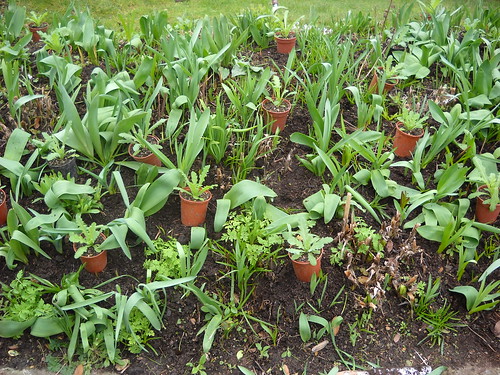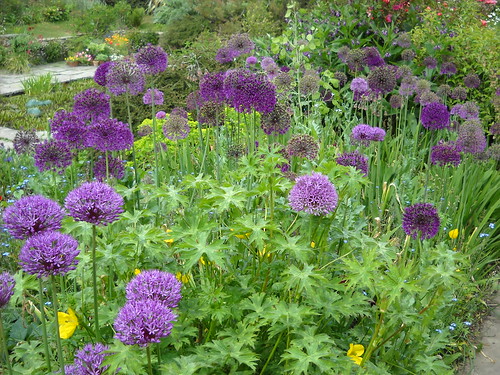One of the most important gardening tools is a well-used notebook. Here's a peek at mine.
19 May 2011
03 May 2011
Weed 'Em and Reap
OK, I know that one's as old as the hills but there are truths to be found in those old sayings and this one really does apply. Weeding is often looked down upon as one of the "lesser" jobs in gardening, one that many people studying horticulture and garden design see as being "beneath them" (I'll withhold pithy comments on weeds being in the ground which is beneath us all).
Many non-gardeners are of the decided opinion that weeding is a monotonous, boring, menial task but I have to agree with Christopher Lloyd who said, "Many gardeners will agree that hand-weeding is not the terrible drudgery that it is often made out to be. Some people find in it a kind of soothing monotony. It leaves their minds free to develop the plot for their next novel or to perfect the brilliant repartee with which they should have encountered a relative's latest example of unreasonableness." (The Well-Tempered Garden, 1973). I think the key word here is gardeners. There is a sharp contrast betwixt gardeners and garden admirers, even - dare I say - garden designers, but that's a post for another time.
Weeding, the act of kneeling on the ground and bending over the soil pulling out those plants which are undesirable thugs or thinning those who have been too rambunctious, to make room for new plants or to give just emerged seedlings a fighting chance at survival, is one of the most important tasks in the garden. Not only does it clear the bed, it helps clear the mind. You're able to really focus on the bed close up, to see what seedlings are coming up, what self-sowers have given you an unexpected and felicitous surprise, what the condition of the soil is - too dry, too wet, too hard, too gritty, whether it could do with more compost, or less. These are just some of the ways the garden communicates to you but you have to bend your ear to the ground sometimes in order to hear it. Besides, I like weeding. I think I've finally got the outline for that best selling novel down!
Weeds are commonly defined as 'the wrong plant in the wrong place', 'a plant growing where we want something else', 'a plant whose virtues have not yet been discovered', etc. Botanically speaking a weed is 'a wild plant growing in competition with cultivated plants'. Most were imported from their native land where they were used in the culinary arts or for medicine, or they hijacked their way to their new homes on imported goods, the seeds stuck to people's clothing, animal's fur, or they hitched a ride on a passing hurricane. Finding themselves in a new, often extraordinarily hospitable climate with no natural predators or grazers to keep them in check, they flung off their inhibitions, went forth and multiplied, squeezed out the more amenable natives and, in some cases, took over the country in the process.
But weeding is about more than removing these undesirable interlopers. It can be about reducing the abundance of desirable plants to create opportunities for more desirable plants. Take this bed: it's just one section of the Barn Garden at Dixter that is designated as a 'bedding pocket', meaning the plants in it are not permanent. This spring Fergus wanted to augment the existing bedding of Allium and Lunaria with Lauren's Grape poppies. In order to do this we had to get down on our knees and weed!
Our task was to remove the true weeds, thin the self-sown Lunaria and Alliums, and in the resulting pockets we would plant the poppies. To help us identify what we were to pull out, Fergus lined up these samples:
The thing about a project like this is that not only do you have to be able to identify the plants being weeded out, you need to understand the plants that are staying. Knowing that the Honesty will overshadow the poppies and inhibit their growth tells you that the seedlings coming up and inch from each other can be thinned so that only a handful of Honesty seedlings remain. Knowing that the wide Allium foliage, likewise, will cover the new plants and that the flower heads are 'this big' will help you realize that they can be extensively thinned otherwise you'll have nothing but a sea of alliums butting heads. Knowing your plants is key, and weeding is one way to get a bird's eye view (especially when the bird is a rather brave Robin scouting for worms in the soil you're disturbing) of them in their various forms throughout the season.
Once the weeding was finished and pockets were created we could place the poppies.
So next time you tell someone you've been weeding the garden and they turn their nose up at such a menial task, you can inform them of their misinformation then laugh all the way to the bank when your novel hits the number one spot on the best seller's list!
Many non-gardeners are of the decided opinion that weeding is a monotonous, boring, menial task but I have to agree with Christopher Lloyd who said, "Many gardeners will agree that hand-weeding is not the terrible drudgery that it is often made out to be. Some people find in it a kind of soothing monotony. It leaves their minds free to develop the plot for their next novel or to perfect the brilliant repartee with which they should have encountered a relative's latest example of unreasonableness." (The Well-Tempered Garden, 1973). I think the key word here is gardeners. There is a sharp contrast betwixt gardeners and garden admirers, even - dare I say - garden designers, but that's a post for another time.
Weeding, the act of kneeling on the ground and bending over the soil pulling out those plants which are undesirable thugs or thinning those who have been too rambunctious, to make room for new plants or to give just emerged seedlings a fighting chance at survival, is one of the most important tasks in the garden. Not only does it clear the bed, it helps clear the mind. You're able to really focus on the bed close up, to see what seedlings are coming up, what self-sowers have given you an unexpected and felicitous surprise, what the condition of the soil is - too dry, too wet, too hard, too gritty, whether it could do with more compost, or less. These are just some of the ways the garden communicates to you but you have to bend your ear to the ground sometimes in order to hear it. Besides, I like weeding. I think I've finally got the outline for that best selling novel down!
Weeds are commonly defined as 'the wrong plant in the wrong place', 'a plant growing where we want something else', 'a plant whose virtues have not yet been discovered', etc. Botanically speaking a weed is 'a wild plant growing in competition with cultivated plants'. Most were imported from their native land where they were used in the culinary arts or for medicine, or they hijacked their way to their new homes on imported goods, the seeds stuck to people's clothing, animal's fur, or they hitched a ride on a passing hurricane. Finding themselves in a new, often extraordinarily hospitable climate with no natural predators or grazers to keep them in check, they flung off their inhibitions, went forth and multiplied, squeezed out the more amenable natives and, in some cases, took over the country in the process.
But weeding is about more than removing these undesirable interlopers. It can be about reducing the abundance of desirable plants to create opportunities for more desirable plants. Take this bed: it's just one section of the Barn Garden at Dixter that is designated as a 'bedding pocket', meaning the plants in it are not permanent. This spring Fergus wanted to augment the existing bedding of Allium and Lunaria with Lauren's Grape poppies. In order to do this we had to get down on our knees and weed!
Our task was to remove the true weeds, thin the self-sown Lunaria and Alliums, and in the resulting pockets we would plant the poppies. To help us identify what we were to pull out, Fergus lined up these samples:
Here are the results of the first go around:
The thing about a project like this is that not only do you have to be able to identify the plants being weeded out, you need to understand the plants that are staying. Knowing that the Honesty will overshadow the poppies and inhibit their growth tells you that the seedlings coming up and inch from each other can be thinned so that only a handful of Honesty seedlings remain. Knowing that the wide Allium foliage, likewise, will cover the new plants and that the flower heads are 'this big' will help you realize that they can be extensively thinned otherwise you'll have nothing but a sea of alliums butting heads. Knowing your plants is key, and weeding is one way to get a bird's eye view (especially when the bird is a rather brave Robin scouting for worms in the soil you're disturbing) of them in their various forms throughout the season.
Once the weeding was finished and pockets were created we could place the poppies.
In the end, this particular combination experiment didn't quite work as hoped because the Alliums flowered before the poppies but it was a great lesson in the importance of weeding, plant identification, design, and experimentation.
Subscribe to:
Posts (Atom)

